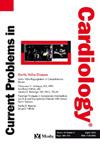心脏淀粉样变:病理生理学和治疗进展的新见解
IF 3.3
3区 医学
Q2 CARDIAC & CARDIOVASCULAR SYSTEMS
引用次数: 0
摘要
心脏淀粉样变性(CA)是一种曾经未被诊断出且往往致命的疾病,现已发展成为一种具有扩展诊断和治疗可能性的疾病。其特点是在心肌细胞外沉积错误折叠的淀粉样蛋白,导致结构和功能损伤。对淀粉样蛋白在心脏组织中的错误折叠、聚集和沉积以及遗传因素的作用的病理生理学的理解的进展在推动诊断和治疗方面取得了关键进展。淀粉样蛋白的沉积可导致显著的心脏表现,包括收缩性心肌病、心力衰竭(保留和降低射血分数)和心律失常,特别是心房颤动,导致大量的发病率和死亡率。诊断方面的创新,如先进的成像技术和新型生物标志物,使早期检测和精确的亚型分化成为可能,强调了靶向治疗的必要性。在过去的十年中,治疗方面的进步已经引入了变革性药物,这些药物获得了FDA批准用于治疗甲状腺转蛋白淀粉样变性(ATTR),包括甲状腺转蛋白稳定剂和沉默剂。目前正在研究诸如基因编辑、反义寡核苷酸和单克隆抗体等有前途的策略。然而,控制心脏表现仍然具有挑战性,特别是在传统药物限制的心力衰竭和心房颤动中优化血液充血和心率控制。这篇综述探讨了CA的发展前景,从病理生理学的见解到创新的治疗方法,并提供了一个全面的方法来管理心脏表现,以应对这种情况的持续挑战。本文章由计算机程序翻译,如有差异,请以英文原文为准。
Cardiac amyloidosis: New insights into pathophysiology and therapeutic advances
Cardiac amyloidosis (CA) is a once underdiagnosed and often fatal condition that has evolved into a disease with expanding diagnostic and therapeutic possibilities. It is characterized by the extracellular deposition of misfolded amyloid proteins within the myocardium, leading to structural and functional impairment. Advances in understanding the pathophysiology encompassing the amyloid protein misfolding, aggregation and deposition in cardiac tissue as well as the role of genetic factors have been pivotal in driving progress in diagnosis and management. The deposition of amyloid proteins can lead to significant cardiac manifestations, including constrictive cardiomyopathy, heart failure (both preserved and reduced ejection fraction), and arrhythmias particularly atrial fibrillation, contributing to substantial morbidity and mortality. Diagnostic innovations, such as advanced imaging and novel biomarkers, have enabled early detection and precise subtype differentiation, underscoring the need for targeted therapies. Over the past decade, therapeutic advancements have introduced transformative medications that gained FDA approval for the management of transthyretin amyloidosis (ATTR) including transthyretin stabilizers and silencers. Promising strategies like gene editing, antisense oligonucleotides and monoclonal antibodies are currently under investigation. However, managing cardiac manifestations remains challenging, particularly in optimizing euvolemia and rate control in heart failure and atrial fibrillation with limitations in traditional medications. This review explores the evolving landscape of CA, from pathophysiologic insights to innovative therapies, and provides a comprehensive approach to the management of cardiac manifestations to address ongoing challenges this condition.
求助全文
通过发布文献求助,成功后即可免费获取论文全文。
去求助
来源期刊

Current Problems in Cardiology
医学-心血管系统
CiteScore
4.80
自引率
2.40%
发文量
392
审稿时长
6 days
期刊介绍:
Under the editorial leadership of noted cardiologist Dr. Hector O. Ventura, Current Problems in Cardiology provides focused, comprehensive coverage of important clinical topics in cardiology. Each monthly issues, addresses a selected clinical problem or condition, including pathophysiology, invasive and noninvasive diagnosis, drug therapy, surgical management, and rehabilitation; or explores the clinical applications of a diagnostic modality or a particular category of drugs. Critical commentary from the distinguished editorial board accompanies each monograph, providing readers with additional insights. An extensive bibliography in each issue saves hours of library research.
 求助内容:
求助内容: 应助结果提醒方式:
应助结果提醒方式:


